Can yoga fix your posture?
With its focus on flexibility and body alignment, can yoga fix your posture?

Yoga is known for a variety of benefits, but can yoga fix your posture as well as helping to increase flexibility and mindfulness? If you’ve been working from a makeshift home office for long periods or find yourself with a pain in the neck from spending hours looking at your phone, you might be looking to fix your posture.
The Cleveland Clinic defines posture as the position in which you hold your body while standing, sitting or lying down. Our everyday movements and activities can affect our body alignment and put stress on joints and muscles, sometimes resulting in pain. The good news is all types of yoga may be able to help with body alignment issues and relieve body stiffness.
• Read more: Best yoga mats
If you have back pain, improving your posture may not fix the root cause of your pain, but it may help alleviate muscle tension. If you have been experiencing back pain for a few weeks or are suffering from an acute injury, speak to your doctor before embarking on a new exercise regime.
Can yoga fix your posture?
Any kind of exercise may help improve your posture, but certain types of exercises, such as yoga, can be especially helpful. In a study published in the Journal of Physical Therapy Science, 80 women aged 50–79 followed a program of intense weekly yoga posture sessions and found it contributed more to improving spine mobility than any other conventional exercise program.

Kerry Maiorca, Board Chair of Yoga Alliance and Owner of Bloom Yoga Studio in Chicago believes that yoga alone will not fix posture, but it can certainly help. She told Live Science, "Yoga can be beneficial for anyone seeking to improve posture because so many of the poses build core strength which is crucial to finding healthy spinal alignment. The mindful practice of yoga also enhances self-awareness, and that can make it easier to notice when you're slumping in your chair or jutting your head forward while using a device."
Which type of yoga is best for your posture?
Yoga and breath–work teacher Geraldine Joaquim told Live Science that body alignment is integral to all yoga poses but cites some specific yoga for back pain poses that can help the shoulders and upper back specifically:
Get the world’s most fascinating discoveries delivered straight to your inbox.
- Cat pose works on moving the chest forwards and back, creating flexibility in the upper back, stretching, and lengthening the spine.
- Bridge pose helps improve strength in the muscles that support the spine.
- Downward Facing Dog can relieve back pain whilst strengthening the muscles by opening the chest and shoulders which can help to straighten vertebrae and align the spine.
- Seated poses such as Dandasana (Staff pose), which is sitting on the floor with legs straight out in front, feet flexed and back straight, strengthens the chest and back muscles as well as stretching the legs and strengthening the abdomen.

Joaquim told Live Science "Yin yoga is especially beneficial for posture, it’s a slow-moving yoga that focuses on the deep connective tissues (ligaments, joints, fascia) rather than the muscles which are the focus in other types of yoga. Yin yoga helps improve flexibility, blood circulation and aids muscle recovery through holding poses for longer, using the breath and relaxing into them – but really most yoga practices will help to improve posture naturally."
• Related: Best resistance bands
How should I sleep to improve my posture?
We spend about a third of our lives sleeping (or attempting to sleep) so our sleep position may be as important to posture as how we sit and move during the day. But is there such a thing as a perfect sleep position?
Chiropractor Philippa Oakley, clinical director at Acorn Health and member of the British Chiropractic Association (BCA) told Live Science, "One of the most optimum sleeping positions is side-lying, with a pillow to support your neck and a pillow between your knees. We typically say to avoid sleeping on your stomach as this can cause neck and upper back pain, but a lot of people can only get beneficial rest if they sleep in this position – so it’s about finding a way to make this position work, which might involve more or different pillows."
"My biggest piece of advice, is not to worry too much about how you’re sleeping – particularly as you’ll move around overnight. We sleep to restore and heal and, if you’re anxious about how you’re sleeping, you won’t sleep as well or as deeply and potentially won’t get the restorative benefits of a good night’s rest."
If you are waking up with back pain and stiffness, try mixing up your sleeping position to see if it helps.
Can you correct years of bad posture?
It might surprise you to learn that there is no medical consensus on what constitutes 'good' or 'bad' posture. A 2012 study from the National Library of Medicine investigated the perceptions of 295 physiotherapists in four different European countries on sitting posture.
• Read more: Yoga myths debunked

The respondents were asked to pick their perfect posture from pictures of nine options ranging from slumped to upright. While 85% chose one of two postures, these were very different, with one having less lumbar curve than the others and a more erect upper back. Overall, disagreement remains on what constitutes a 'correct' spine posture, and what is the best sitting posture.
Philippa Oakley of the BCA says trying to correct what you believe to be bad posture can actually cause pain. She told Live Science: "Worrying about maintaining ‘good posture’ by drawing in the stomach muscles, bracing the lower back and generally stiffening your body can, in fact, lead to more pain. We need to be less concerned about undoing what is perceived as bad posture and concentrating on moving well and often – particularly as so many of us work in static positions for much of the day."
"It’s important to incorporate regular movement into your everyday routine to reduce and alleviate pain. If your work involves you sitting at a desk for a long period of time, make sure you take regular breaks to stand up, move around and do some deep breathing. Chiropractors can work with you to reduce pain and improve mobility in your joints and muscles as part of a package of care which can get you moving and feeling better."
Catherine is a freelance journalist writing across titles such as Verywell Health, Healthline, The Daily Telegraph, Refinery29, Elle, and Vogue. She specializes in content covering health, fitness, wellness, and culture. Catherine worked in healthcare administration and communications for a decade, producing easy-to-understand patient information for a wide variety of health conditions.



